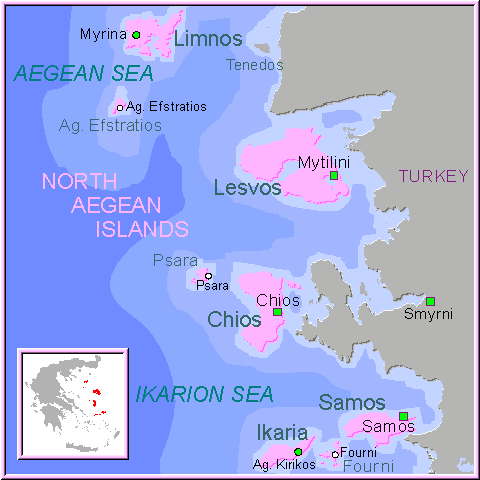 Map & Synopsis: Greek Islands of the N.E. Aegean Group
Map & Synopsis: Greek Islands of the N.E. Aegean Group These five islands to the north of the Dodecanese, which flank the northern part of the Asia Minor coast of present dayTurkey, do not really constitute an island group, but are best seen as individual islands/islets, given the rather unique character of each.
Samos is by far the most touristic of these islands, and most mountainous and densely forested, though fires did serious damage to the latter from 1987 to 2000.
Samos has three ports, the most touristic of which is Pythagorio on the southeast coast, though with nice old town with cobbled lanes and mansions. The port of Vathy (Samos Town), has a beautiful old village up above the harbor, with Turkish houses with red tiled roofs. In late August there's a wine festival in the harbor. The plateau to the east is covered with vineyards, with lovely hill villages and more wine country near the north central coast.
Samos has sandy beaches, ancient sites, inland valleys and hill villages, a nature reserve in a salt marsh lagoon with migrating birds (between November and July) at Aliki. The port of Karolvassi on the northwest coast is the least touristic of the three ports. See Island Guide? See Eco Guide?
Ikaria, west of Samos, is also mountainous, parts of both north and south coast steep and rugged, but with some lovely wooded villages in the northern (Rahes region). The southern port and capital of Aghios Kyrikos in the south, has a pretty harbor with neoclassical buildings and an impressive church, a fine old bakery, some rooms and tavernas. The ride to the north coast along the mountain spine of the island is dramatic, and not for poor or squeamish drivers.
Evdilos is the northern port, linked with Pireas and the Cyclades; Armenistis is the biggest tourist resort, with long sandy beaches popular with surfers. The valley of Langadha in the southwest is the scene of a huge 15th of August celebration, with feasting and folk dancing. See Eco-Ikaria Guide? See Ikaria Greek Island Guide?
Hios (or Chios) island is also rugged and mountainous and receive smaller numbers of tourists than Samos or Lesvos. The waterfront of its harbor is rather daunting at first sight from the ferry, rebuilt in stolid concrete after the 1881 earthquake, but back in there's a great market area, good museums, good food and inexpensive rooms. To the south of the city is the Kambos area with gorgeous mansions and orchards.
Hios is known for its medieval mastic villages, where this sticky resin, much favored by the Ottomans, is extracted from lentisk trees. A fascinating art form, learned from the Genoese, is found in these villages, with geometric patterns incised into walls of houses.
One of the great monuments of ecclesiastic architecture is the 11th century monastery church of Nea Moni, in the island's center; there are many churches and monasteries on the island, fishing villages, good beaches, the smaller island of Inousses off of the east coast, home to many of Greece's ship owning families; the larger small island of Psara is off to the northwest. See Island Guide?
Lesvos (also called Mytilini) is Greece's third largest island, with 11 million olive trees, which produce ¼ of Greece's olive oil; it is also the ouzo capital of Greece, its distilleries in the fascinating old town of Plomari on the south coast.
 Two inland gulfs penetrate the island, the larger one of Kalloni with a lush plain in the island's center, and around the bay a famous bird watching area. The hill towns of Ayiassos, and Molyvos (south and north respectively), the petrified forest and long beach of Eressos in the west, the several hot mineral baths scattered around the island, some fine beaches and superb walking country, all make this large island a fascinating place to take one's time exploring. Not least important is the main town and capital (called Mytilini), of 30,000 inhabitants, with its neoclassical long crescent waterfront, with its appealing old market streets back in, with fish markets, antiques, wood and metal shops, and on a headland to the north, a fortress, with a mosque and Turkish bath house behind it.
Two inland gulfs penetrate the island, the larger one of Kalloni with a lush plain in the island's center, and around the bay a famous bird watching area. The hill towns of Ayiassos, and Molyvos (south and north respectively), the petrified forest and long beach of Eressos in the west, the several hot mineral baths scattered around the island, some fine beaches and superb walking country, all make this large island a fascinating place to take one's time exploring. Not least important is the main town and capital (called Mytilini), of 30,000 inhabitants, with its neoclassical long crescent waterfront, with its appealing old market streets back in, with fish markets, antiques, wood and metal shops, and on a headland to the north, a fortress, with a mosque and Turkish bath house behind it.
A branch of the University of the Aegean has its home in this attractive place; there are also some fine museums, and just to the north, in Varia, the Theophilos Museum, with the works of the famous eccentric 'naïve' from Lesvos. See Island Guide? See Eco Guide?
Limnos is the least mountainous of the East Aegean islands. It produces wine, retsina, grain, sheep's milk cheese, honey, vegetables and meat.There are many trees and streams on the island and some good beaches, ancient sites, a hot springs spa, nice villages, the smaller island of Aghios Efstratios to the south, with wooded valleys and a long, unspoiled beach where people like to camp. See Island Guide? See Eco Guide?
Thassos Eco guide, Thassos Island Guide, Samothraki Eco-guide, Samothraki Island Guide